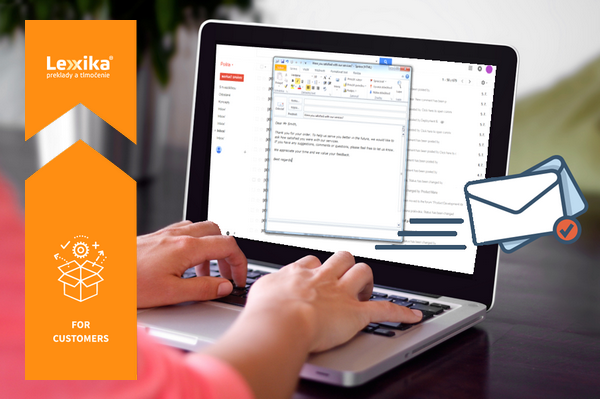How to properly write formal emails in English
Stanislava Dengová 05.07.2018 For Customers Reading time: 3 min.
05.07.2018 For Customers Reading time: 3 min. 
Nowadays, emails are commonplace or even inevitable and many of us write work emails on a daily basis. We write them automatically, based on our habits and many times, we don’t really think about what’s formally correct. You might not realize this, but a/n (im)properly written work email is an advertisement for both you and the company you represent. So how do you properly write formal emails?
General rules
At first, let’s go through some general rules that apply to every formal email, no matter the language of communication:
- Always fill in the subject line to characterise the content of your email.
- Start the email with a salutation.
- Keep the message short, clear, and well arranged. By choosing short and simple sentences, you can reduce the possibility of making a mistake, which is especially useful if you write in a foreign language.
- Grammar errors, excessive use of exclamation marks, emoticons or writing in caps have no place in formal emails.
- Close every formal email with a polite phrase, salutation and signature.
Mr, Mrs, Ms,...
Simple as it may sound, you might get stuck right at the opening salutation. In English, the most widely used form of salutation is Dear + title + addressee's surname. You can use titles like Mr (man), Mrs (married woman), Miss (single woman), or Ms (if you’re not sure whether you should use Mrs or Miss). Always write these titles abbreviated rather than in words, but there are exceptions like Professor, Judge, etc. In case you don’t know the name of the addressee, you can use a neutral salutation like To whom it may concern or Dear Sir or Madam. In formal emails, don’t use greetings like Hello, Hey, and Hi. After the salutation, write a comma followed by a space line, and then start the first sentence with a capital letter.
I’ve got the salutation, what’s next?
You often consider how to word the email introduction, too? If you’re replying to a previous conversation, you can use sentences like “Thank you for contacting us”, “Thank you for your prompt reply”, or “Thank you for getting back to me”. Of course, it always depends on what you are reacting to, but the best way to start a formal email is by thanking the sender. If you’re not replying to a previous conversation, you can begin with “I am writing to enquire about…” or “I am writing in reference to…”. However, remember that emails should be short and clear, so mention only the most important things.
Even brevity has its limits
It’s important to note that a formal English email should be written in the formal English language, since English is known for various contractions (I’m instead of I am) and abbreviations (ICYMI = In case you missed it). These should be avoided in a properly written formal email. Trying to be brief is no excuse for writing sentence fragments with incorrect punctuation, using slang or overly informal words and phrases.
Be polite when writing the closing phrases, too
Don’t forget to include a polite phrase at the end of your email. Depending on the content of the email, you can write “Thank you for your patience and cooperation”, “Thank you for your consideration”, “If you have any questions or concerns, do not hesitate to let me know” or “I look forward to hearing from you”. The very end of an English email is actually a piece of cake. Most often, you will use greetings like Best regards, Kind regards or Yours sincerely followed by your name. In case you don’t know the name of the addressee you can use Yours faithfully.
It can’t hurt to read a couple of sample emails on the internet. If you’re not sure about a phrase or a clause, you can simply check its correct usage on Google. Even though it’s not a bulletproof method, you can at least be sure that the sentence needs revising if you cannot find a single mention of the phrase.
It’s true that emails serve as a fast means of communication, but you should always give them enough time. All you really have to do is respect a few rules and people will surely notice it and appreciate your effort.

I began working at LEXIKA as a recent graduate in translation and interpreting studies. At university I took a class in which we simulated a translation project thanks to which my vision for the future was clear – I wanted to work at a translation company after graduating. I am happy to have landed a job at LEXIKA where I have been working since then :). I primarily oversee translation projects and communicate with our clients and translators. Sometimes I contribute to our internal documentation and since I am a certified memoQ trainer, I am in charge of our CAT tools and together with my colleagues I organize memoQ training courses for beginning and advanced translators.
Share it!